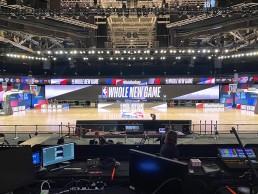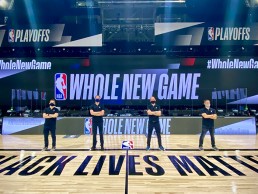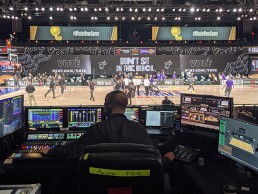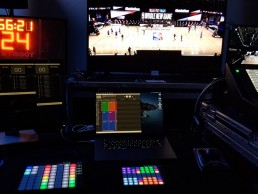This website uses cookies so that we can provide you with the best user experience possible. Cookie information is stored in your browser and performs functions such as recognising you when you return to our website and helping our team to understand which sections of the website you find most interesting and useful.
NBA Bubble
ProjectNBA BubbleLocationOrlando, USAManufacturers MA Lighting, disguise, Riedel, JBL Pro, Quantum5X, Barco, DiGiCoInstallerFirehouse Productions / Fuse Technical GroupSubmitted by disguise
It’s been a turbulent, challenging year within the world of sports, with every major league disrupted by the COVID-19 pandemic. However, when faced with difficulties on a scale like no other, the industry has gone to extraordinary lengths to adapt and bring sport back for fans in any way possible. The approach taken by the NBA is the perfect example of planning, ingenuity and determination, resulting in the impressive 2020 NBA Bubble.
In a bid to protect the players, staff and crew from the pandemic during the final eight games of the 2019-2020 season, as well as the 2020 NBA playoffs and finals an isolation zone – or ‘bubble’ – was created at Walt Disney World in Florida, Orlando. There were 22 NBA teams invited to participate – all staying at Disney World hotels – with all games being held behind closed doors at the ESPN Wide World of Sports Complex. The project was a $190m investment approved by the NBA in June following the suspension of the season in March.
After three exhibition scrimmages at the new, temporary venue in late July, the teams invited to the 2020 NBA Bubble played eight regular season games to determine the seeding for the playoffs, which began on August 17. The NBA finals started on September 30 and ended on 11 October, with the Los Angeles Lakers defeating Miami Heat.
In the end, the 2020 NBA Bubble had no recorded cases of COVID-19 for any of the teams involved. Although there was some mixed reaction from players and coaches initially, the project was a huge success – and that was, in no small part, thanks to the array of state-of-the-art technology used to deliver this project.
Firehouse Productions were enlisted to provide the audio, communications and RF coordination for the NBA Bubble. Mark Dittmar, VP at Firehouse Productions, takes up the story: “We have provided sound reinforcement, communications and RF coordination for NBA games, All-Star and special events for the last decade. We maintain a solid working relationship with the organization, so, as a result, there is a mutual trust which allows our team to react quickly to unique situations, designing and deploying multiple systems in a short time frame with outstanding results.
“When the NBA season stopped on March 11, we had just finished the All-Star Game two weeks prior. LeBron James was on television saying he would never play basketball without fans because the fans are everything to him. The next morning, I woke up with this very strange idea in my head of ‘what if he didn’t know there weren’t fans.’ I called the NBA, a very good client of ours, and pitched the idea. Within a week, they’d bought in fully and we started preparing for the first tests.
“There were four to six weeks of meetings, both virtual and in person, leading up to a demo event for the NBA at a local basketball court in Red Hook, NY. Once we arrived in Orlando, there were two weeks of load in time to install tech and test all three arenas and the broadcast systems.”
Within the NBA Bubble, there were three courts used – the Arena, the main court for televised games, including the NBA Finals; the Field House, the second court which was also used for televised games up until the finals; and the Visa Athletic Center, which was used for non-national games.
The initial plan was to use one PA system for crowd sounds in each of the venues, however, that soon changed to two PA systems – one for the court and another for the audience.
Vinny Siniscal of Firehouse Productions explained further: “The system design was a 10.6 surround setup encircling the arena floor, aimed at the court, instead of the fans, as would normally be the case. A separate PA was also installed as coverage for the in-house seating of a COVID-19-tested audience from the Bubble. Every array had to be flown around massive LED walls, as well as the lighting and broadcast gear.”
The audio system for each court within the venue was the same, with 10 hangs of six loudspeakers, six low hangs and four hangs placed at a high angle to deliver an authentic sound from the upper decks. The Arena used K2 loudspeakers from L-Acoustics, with the other two courts using L-Acoustics’ KARAs.
The audience PA system in the two main venues, on the other hand, used three hangs of eight JBL Pro VTX V20 loudspeakers, with VTX S25 subwoofers, supported by additional Firehouse F12s on the upper deck delays.
“The NBA has a very strict 85 dB limit on the PA system, so intelligibility becomes everything,” explained Mark. “When you can go up to 100 dB, you don’t need as much intelligibility, because you can just turn it up and people can hear it. When you have an 85 dB limit, that’s a very different game. You need to be intelligible above the audience sound.
“For most of my shows, and for the NBA in particular, I’ve been using JBL VTX V20 loudspeakers for a number of years. With their intelligibility, size and power factor, they’re just spectacular. The 105-degree pattern really lets me cover a lot, and they sound great. Part of what I like about JBL is that it’s very consistent and reliable for me. I don’t have to worry about intelligibility or things like that, so I don’t have to get into a complicated design. I like to keep it very, very simple.”
“The subs are my favorite thing out there,” added Mark. “Up until I saw this product, I hated 15-inch subs. Then the S25 came out, and I don’t know what they did or how they did it, but it’s a huge amount of power in a very small package. I use it all the time. It’s designed to work with the V20s, and it’s got way more low-end than any double 15 I’ve ever worked with in my life.”
Firehouse Productions also selected Crown I-Tech 4x3500HD and 12000HD amplifiers to power both audio systems. Featuring BSS OMNIDRIVEHD processing with linear phase FIR filters and the acclaimed LevelMAX Limiter Suite, both models provide crystal-clear amplification with ample headroom. Network connectivity via HiQnet and Ethernet protocols provided a high degree of control and real-time diagnostics, too.
“The court system mixers were DiGiCo SD7’s each with 180+ inputs. A network of Yamaha QL1’s, six in total, were used to route the audience sweetening. Figure 53’s Q-Lab multimedia playback software was used to trigger the immersive audio on two Mac Book Pros with four Novation Launch Pads and two iPads for each venue as the HUI,” said Vinny.
Firehouse Productions strived to get the crowd sound as realistic as possible, which isn’t as simple as it seems.
“The audio design was, at first, a little too perfect. Fans don’t cheer in perfect stereo and chants don’t happen in perfect unison – instead, they start in different parts of the arena and grow slowly,” added Mark.
With this in mind, Firehouse’s Director of Engineering, Paul Bauman, was brought in to “mess things up” and make the experience of playing on the court feel more realistic. Using the Los Angeles Staples Center as a sample, Paul’s audio simulation software approximated audience noise from the upper and lower bowls. The arrays that were generating sound from the upper bowl were delayed so the sound arrived later on the court. Then, higher frequencies were rolled off making things sound more natural.
Firehouse Productions also deployed a landmark Riedel solution, which enabled officials, coaches, and production personnel to communicate safely.
“This was a complex installation, and there’s no way we could have met all of the NBA’s comms requirements with any intercom manufacturer other than Riedel,” said Vinny. “Working with the Riedel team, we were able to design a truly elegant and integrated solution that enables crystal-clear communications while also ensuring that officials, coaches, and producers maintained safe distances from each other.”
“The ability to add custom logic to the Artist network is a huge plus because it allowed us to build in more redundancy and ensure effective monitoring for the entire intercom ecosystem. It’s an example of why Firehouse chose Riedel – and why Artist and Bolero are our go-to solutions for big events.”
Firehouse used 12 Riedel Artist intercom nodes, providing almost 500 active communications ports to support 113 master panels; 57 Performer C3 intercom beltpacks; 116 Bolero wireless intercom beltpacks; and 186 analog 4-wire connections to six onsite OB trucks. Deployed in a fully redundant fiber ring configuration, the Artist nodes are able to support users communicating via Bolero beltpacks throughout the vast ESPN complex – including players, coaches, and officials in the green zone, where games are played on three venues, and the yellow zone, encompassing the technical and broadcast compound.
Using Bolero, personnel who could no longer speak directly with each other due to social distancing measures could then communicate clearly and easily. For instance, coaches and officials were able to converse with scorers and other game personnel sequestered behind plexiglass shields at courtside. Luis Espinal, Intercom Curator for the Firehouse team, built custom logic functions into the Artist nodes that allow specific mic feeds to be routed to specific broadcast trucks. The onsite Bolero universe, based on two fully redundant hub-and-spoke networks of Luminex switches, offers up to 128 multicast flows – giving the deployment room to grow as and when more beltpacks are needed.
“The NBA Bubble is a perfect example of thinking outside the box to ensure continuity for one of the world’s most popular sports, and we’re proud that Riedel has been able to play such a key role,” said Joyce Bente, President and CEO, Riedel North America. “Once again, our partnership with Firehouse Productions has ensured a smooth and highly creative deployment that meets the NBA’s stringent requirements for safe and reliable communications.”
Firehouse’s attention to detail and overall delivery was certainly one of the main reasons behind the NBA Bubble’s success. It was huge effort by the team, providing complete audio coverage, communications and RF coordination in just over six months, from inception to completion.
Faced with the additional challenge of how to safely implement distanced workflow while capturing in-game player audio, the NBA chose Q5X remote controlled PlayerMics to produce ‘miced up’ segment.
Q5X manufactures PlayerMic wireless microphone transmitters that are designed for the rigours of professional sports; safe, rugged, sweat-proof and totally remote controlled. The sealed, flexible rubber packages contain a rechargeable lithium polymer battery, which will run for either four hours or eight hours, depending on the model, selected. These features are not new, but translate perfectly into the reality of COVID-19 distanced workflow. The transmitters are completely sanitisable and can be operated remotely with a handheld MicCommander, allowing users to safely observe social distancing protocols. The need to be sweat-proof requires sealed designs without leaky battery chambers or control elements on the transmitter package. Sanitising a Q5X transmitter is as easy as sanitising an iPhone; just wipe it down with the approved alcohol-based disinfectant.
In sports broadcast, the sanitised transmitters are typically placed in the padding or jersey, well in advance of the game – this is effectively micing the equipment rather than the player. The NBA placed the Q5X PlayerMic transmitters in a custom pocket stitched under the arm, on the side of every game jersey. The mic element is then taped to the inside of the collar, with the mic cable securely taped to the inside of the jersey.
From this point forward, the transmitters are controlled remotely using the handheld MicCommander at distances of 50 metres or more, so there is no need for the A2 technician managing the audio to approach the players. All features of the transmitters can be controlled from outside of the locker room or from the perimeter of the playing surface.
Bodypack transmitters for coaches and game officials present similar challenges for distanced workflow. The Q5X CoachMic and RefMic bodypacks offer the same advantages as the PlayerMic, with an easily sanitisable design and remote control of all transmitter parameters. Both of these transmitters are a one-piece solution, featuring a large, integrated, rocker-style mute switch so the coach or referee can either mute the transmitter for sensitive conversations or activate it for announcements. The transmitter bodypack and attached microphone element can be placed in standby mode, bagged and left in the dressing room for the coach or referee to install themselves.
For the visual element of the NBA Bubble, it was Fuse Technical Group that supplied all the impressive court video systems for the three venues. Each basketball court was created with giant, wraparound LED video screens, topped by graphics displays.
A pre-recorded national anthem, as well as player intros, were displayed on the screens before the start of games and virtual fans were shown enjoying and reacting to game play. To customise the courts for the designated ‘home team’, a database of music, audio cues and graphics that the teams would ordinarily use in their home arenas was used, with the dynamic audio and video elements building in intensity as the playoffs progressed. A bank of in-game reactions was also developed to support big plays and help support the natural momentum of the game.
To achieve this, Fuse provided four programmers, with an arsenal of grandMA hardware to play back and trigger various assets and effects during the games. This included five grandMA3 full-size units with one MA NPU (Network Processing Unit), plus two grandMA2 full-size and one grandMA2 consoles, with the latter as backup systems and the tech desk.
“The NBA wanted to create an interesting on-camera experience that would engage as many fans as possible. The solution they arrived at was to line the courts with a U-shaped LED arrangement,” explained programmer, Jeremy Lechterman, Principal of FragmentNine, a live event creative direction company. “That high-resolution element was primarily used to display team content and the virtual fans, while a low-res ribbon element was hung above to simulate traditional in-arena video.”
In addition, a scoreboard element – approximately one-quarter the size of a typical centerhung arena scoreboard – was set on the side under the camera platform – this was primarily for coaches and players.
The grandMA3s were programmed to integrate with 13 disguise gx 2c media servers, which handled the teams’ screens content, and a Barco E2 system, which switched the virtual fans, the disguise team content, stats, and the program cut from broadcast.
During the one-week quarantine transition into the NBA Bubble, the production team made use of disguise’s pre-visualisation to review content and cue up sessions with the screens producers via Zoom. The team decided to use disguise’s Sockpuppet workflow to enable them to respond quickly to game play and the evolving nature of the overall game experience. Games were played on three courts simultaneously where any of the 22 teams could be the home team, so Fuse kept its grandMA3 consoles in network together to continually update programming and move it to different courts based on which teams were playing where each day
“We needed some software tweaks along the way to optimise our workflow and were very appreciative to be working with disguise, which had the resources to get us updates within a day,” added Charles Dabezies of Fuse. “This was certainly an edge case; none of us had done a show with 14,000 plus media files, and it pushed the disguise workflow to the limits. The disguise team was able to reinvent some aspects of the UI to help us handle this massive amount of data. With disguise being so flexible, there was never a choke point to the league or team’s creativity.”
“This was the first time any of us [programmers] had done sports and the first time this format was used,” Jeremy pointed out. “The grandMA3 is not the system typically used in these teams’ home arenas to handle video. None of the usual in-arena systems could be used in the Bubble where we needed to serve up content for 22 teams and have multiple simultaneous users. Without the grandMA3, there wouldn’t have been a solution.”
The NBA Bubble marked the first time any of the programmers had used grandMA3 hardware for a long-term show, although the grandMA3 is their platform of choice. “We came to the grandMA3 with muscle memory from the grandMA2, and it didn’t take us long to adapt to the grandMA3,” added Jeremy.
He praised to the grandMA3’s multi-user environment – something not found on other platforms: “We had four programmers working independently at the same time and handing the programming seamlessly. We built a complex series of macros to achieve this, but we were able to program four games simultaneously without stepping on each other.”
Programmer, Michael “Hank” Hankowksy, revealed that there were 7,000 individual clips by the middle of the process. He continued: “The grandMA3 is so extensible; we could write custom script to automate a lot of the data entries. Then, with data and preprogrammed looks in the desk, we could copy and paste them where we needed them.”
“It was amazing the way Hank really scripted the consoles,” said Chris Peterson, Vice President of Entertainment at Fuse Technical Group. “The ability to parse large amounts of data and build huge cue lists was instrumental in the success of this job.”
During the seeding games, the programmers typically worked games at FOH alongside a screens producer representing their own team’s in-arena presentation. The screens producers were armed with Novation Launchpad X MIDI loaded with in-game reactive elements, such as player headshots and animations for a three-pointer or a spectacular dunk, for example.
“Because they understood basketball better than we did, they could trigger those elements on their own in the grandMA3 via the MIDI pad,” furthered Jeremy. “While we were handling the big switching elements – the virtual fans, the video packages, time-out highlight reels – they could quickly trigger all the game play reactions.
“On the corner screens in the ribbons, we were tasked with displaying and changing sponsor advertisements and specific intervals on the game clock. This was accomplished with Cycling 74’s Max 8, which read the incoming game clock signal from Mixon Stats and sent DMX triggers to the consoles.
“System Engineer, Josh Flitel, also wrote a Universe show control file to give us full access to the E2s and routers from the desk. The entire show could be run using the grandMA3 as the only control surface. Josh did an incredible job building out this handshake between all the parts of the system.”
Content was constantly upgraded as the season progressed and milestones were marked. “As of September 10, the media managed totaled 14,200 individual video clips,” Hank added. “Changes were still being made as we reached the Eastern Conference finals. Having the grandMA3’s flexibility to make changes on the fly was invaluable – everyone was very pleased with the system’s performance.”
“This was a totally new experience for the NBA, as well as the teams involved,” concluded Charles. “Our largest challenge was understanding how to adapt 22 different team’s shows for this new environment. Adapting a traditional basketball game to this layout was new for everyone”
It may have been a project like no other for all those involved, with the scale of the task being truly incredible. However, that has only made the NBA Bubble project all the more impressive. Everyone was aware that – like all sports – it just wouldn’t be the same without the fans at the venue, but, despite the obstacles, everyone involved in the project has achieved something special. The 2020 NBA Bubble shows how technology can enhance the sporting experience, whatever the situation may be.
Xxx






